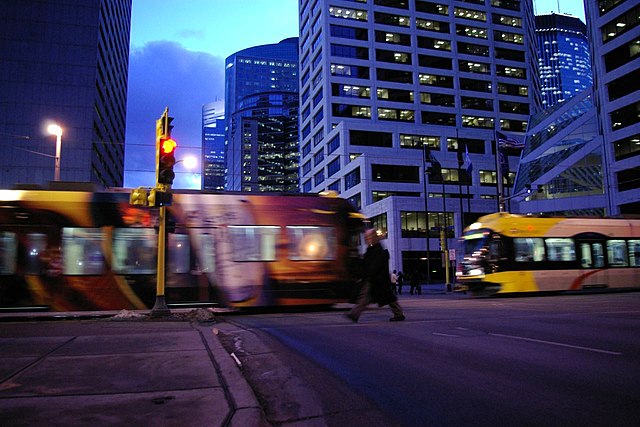Metro Transit has raised the projected cost of the Twin Cities’ Southwest light-rail line to $2.86 billion, or $197 million per mile for the 14.5 mile line. The news stories say this is up from $2.0 billion, but the original projected cost was $1.25 billion for 15.8 miles or less than $80 million a mile (which is still outrageous for an inflexible, low-capacity system).
Light-rail trains pass through a half-empty downtown Minneapolis. Photo by Andrew Ciscel.
Considering that downtown Minneapolis is ranked as having the third-slowest recovery of the nation’s 56 largest urban areas, and Twin Cities light rail carried only 52 percent of pre-pandemic riders in November, this would be a good time for the region to scrap the project. As I’ve suggested before, it would cost a lot less to turn it into a rapid bus route than to complete the rail project.
In related news, my friend Wendell Cox has an article on New Geography about a recent report from Yogi Wang and David Levinson reviewing than three dozen light-rail projects and showing that modest bus improvements would have been far more cost effective at carrying transit riders than building those projects. Wang and Levinson work at the University of Sydney in Australia, but Levinson previously worked for the University of Minnesota Accessibility Observatory and pioneered its accessibility index that I’ve frequently cited here.
The projects reviewed by Wand and Levinson ranged from San Jose’s first light-rail line that was completed in the late 1980s to several lines completed in the early 2010s. It is worth noting that many of the analyses prepared for these projects didn’t consider any real alternatives to light rail. In fact, only four of the 43 projects reviewed had bus-rapid transit, the closest bus analog to light rail, as an alternative. Instead, the alternatives reviewed by Wang and Levinson were generally called something like “Transportation System Management” and consisted of modest upgrades to the bus systems.
I suspect one reason why Wang and Levinson didn’t consider any more recent projects is because, under rules approved by the Obama administration, the alternatives analyses are even weaker, either not considering alternatives at all or not bothering to do a detailed enough evaluation of those alternatives to make the kind of comparisons Wang and Levinson made.
All of which points to transit agencies simply not caring about how much of the taxpayers’ money they waste building rail transit projects that don’t meet the transportation needs of 21st century cities. Indeed, the more money they spend, the better they feel about themselves.









Ford has taken the wraps off the new Transit Custom, following the recent debut of the fully electric e-Transit sibling. Starting from 2023, the new generation of Ford’s popular light commercial vehicle will be available with EcoBlue diesel, PHEV, and EV powertrains
https://www.autocar.co.uk/sites/autocar.co.uk/files/styles/gallery_slide/public/images/car-reviews/first-drives/legacy/2023_ford_e-transit_courier_front-three-quarter_0.jpg?itok=HLVchsBH
Era of MASS transit, is largely over. Era of small box transit will emerge, provided we get the regulatory hurdles out of the way